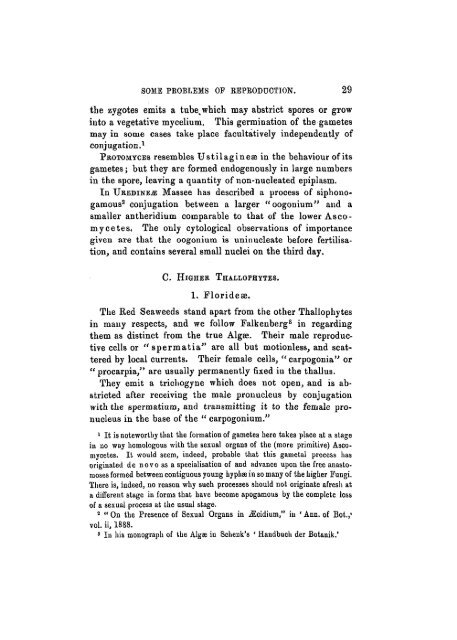Some Problems of Reproduction: a Comparative Study of ...
Some Problems of Reproduction: a Comparative Study of ...
Some Problems of Reproduction: a Comparative Study of ...
Create successful ePaper yourself
Turn your PDF publications into a flip-book with our unique Google optimized e-Paper software.
SOME PROBLEMS OF REPRODUCTION. 29<br />
the zygotes emits a tube^which may abstrict spores or grow<br />
into a vegetative mycelium. This germination <strong>of</strong> the gametes<br />
may in some cases take place facultatively independently <strong>of</strong><br />
conjugation. 1<br />
PROTOMYCES resembles Ustilaginese in the behaviour <strong>of</strong> its<br />
gametes; but they are formed endogenously in large numbers<br />
in the spore, leaving a quantity <strong>of</strong> non-nucleated epiplasm.<br />
In UREDINEJE Massee has described a process <strong>of</strong> siphonogamous<br />
2 Conjugation between a larger "oogonium" and a<br />
smaller antheridium comparable to that <strong>of</strong> the lower Ascomycetes*<br />
The only cytological observations <strong>of</strong> importance<br />
given are that the oogonium is uninucleate before fertilisation,<br />
and contains several small nuclei on the third day.<br />
C. HIGHER THALLOPHYTES.<br />
1. Floridese.<br />
The Red Seaweeds stand apart from the other Thallophytes<br />
in many respects, and we follow Falkenberg 3 in regarding<br />
them as distinct from the true Algse. Their male reproductive<br />
cells or "spermatia" are all but motionless, and scattered<br />
by local currents. Their female cells, " carpogonia" or<br />
" procarpia," are usually permanently fixed in the thallus.<br />
They emit a trichogyne which does not open, and is abstricted<br />
after receiving the male pronucleus by conjugation<br />
with the spermatium, and transmitting it to the female pronucleus<br />
in the base <strong>of</strong> the " carpogonium."<br />
1<br />
It is noteworthy that the formation <strong>of</strong> gametes here takes place at a stage<br />
in no way homologous with the sexual organs <strong>of</strong> the (more primitive) Ascomycetes.<br />
It would seem, indeed, probable that this gametal process has<br />
originated de novoasa specialisation <strong>of</strong> and advance upon the free anastomoses<br />
formed between contiguous young hyphse in so many <strong>of</strong> the higher Pungi.<br />
There is, indeed, no reason why such processes should not originate afresli at<br />
a different stage in forms that have become apogamous by the complete loss<br />
<strong>of</strong> a sexual process at the usual stage.<br />
s<br />
" On the Presence <strong>of</strong> Sexual Organs in iEcidium," iu ' Ann. <strong>of</strong> Bot.,'<br />
vol. ii, 1888.<br />
3<br />
In his monograph <strong>of</strong> the Alg» in Schenk's ' Handbuch der Botanik.'

















